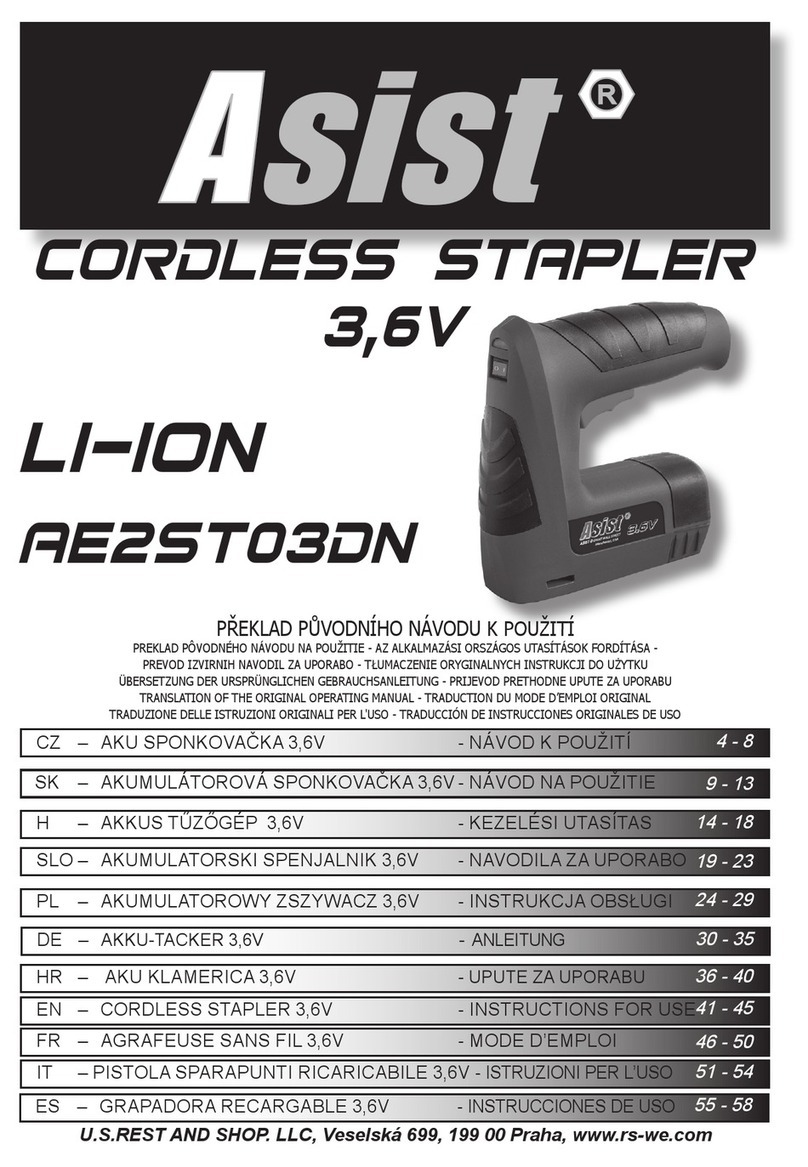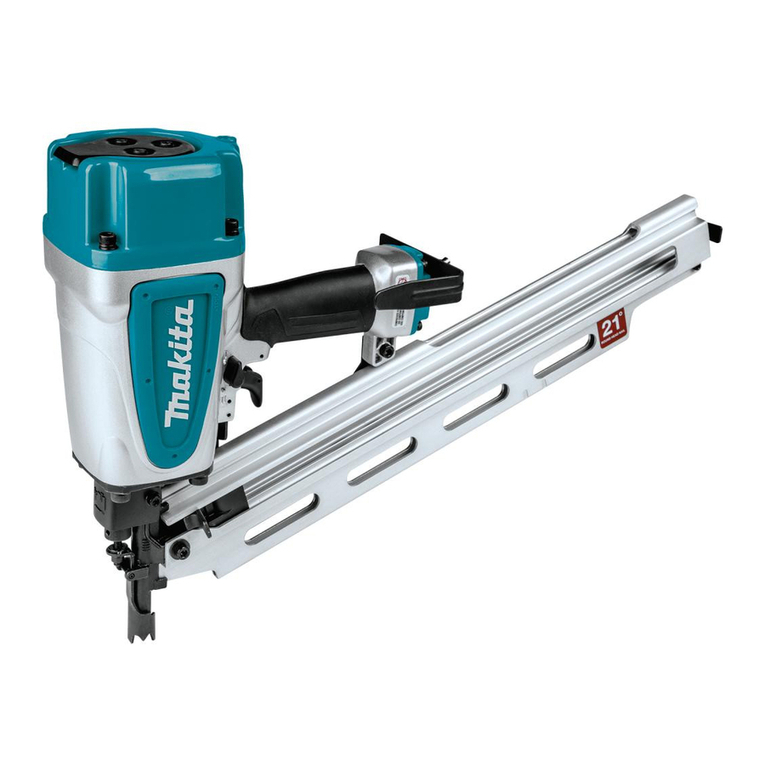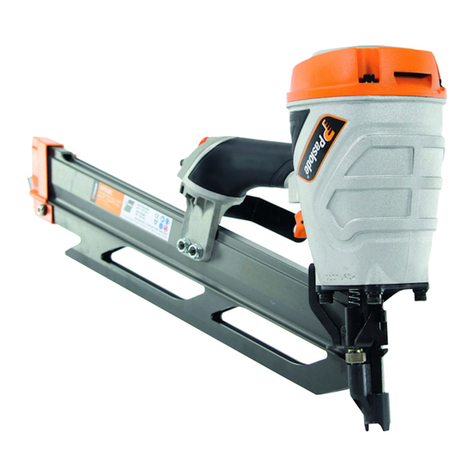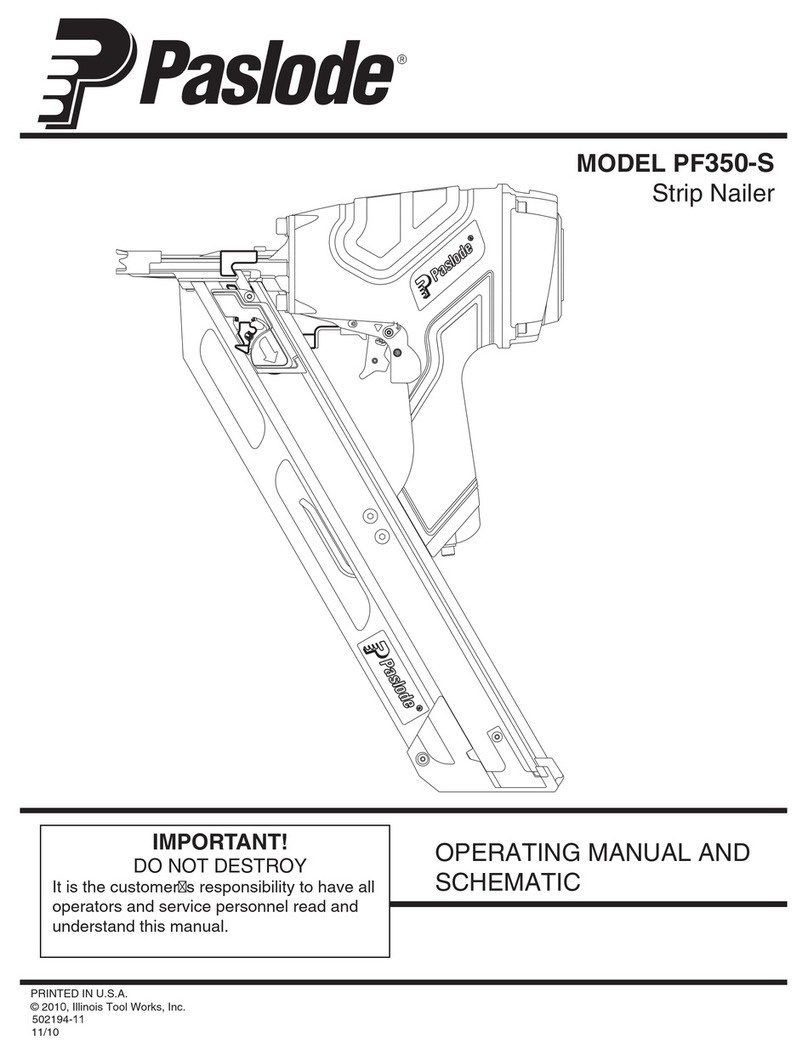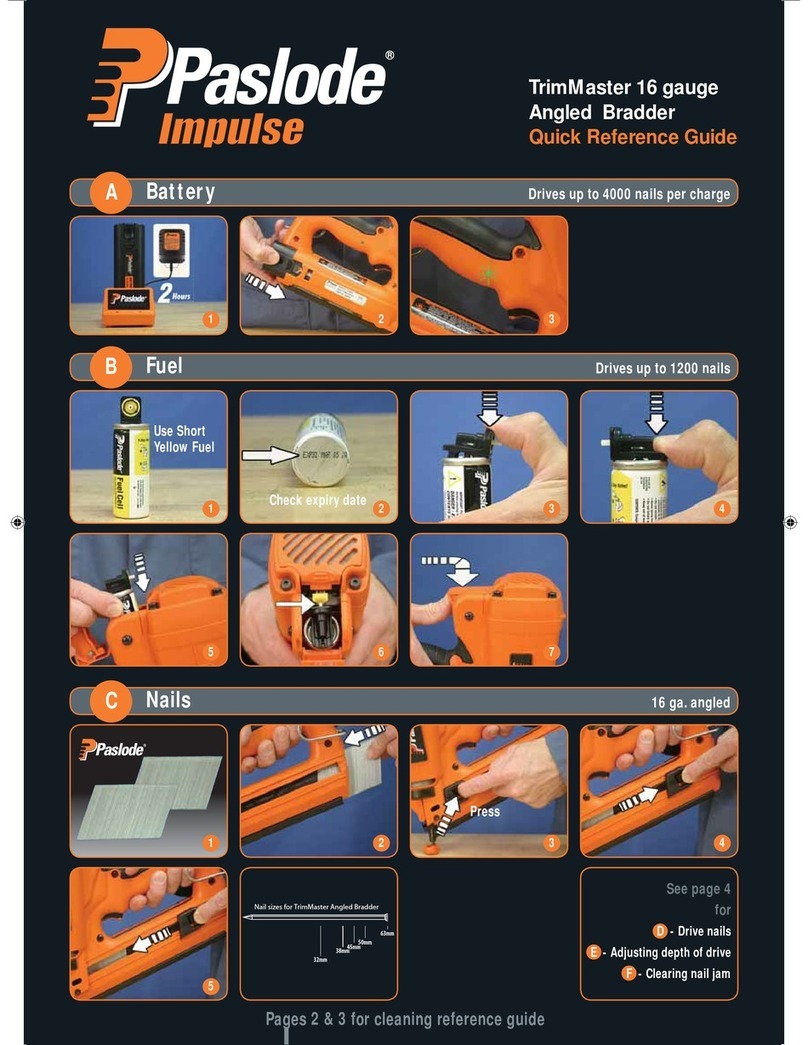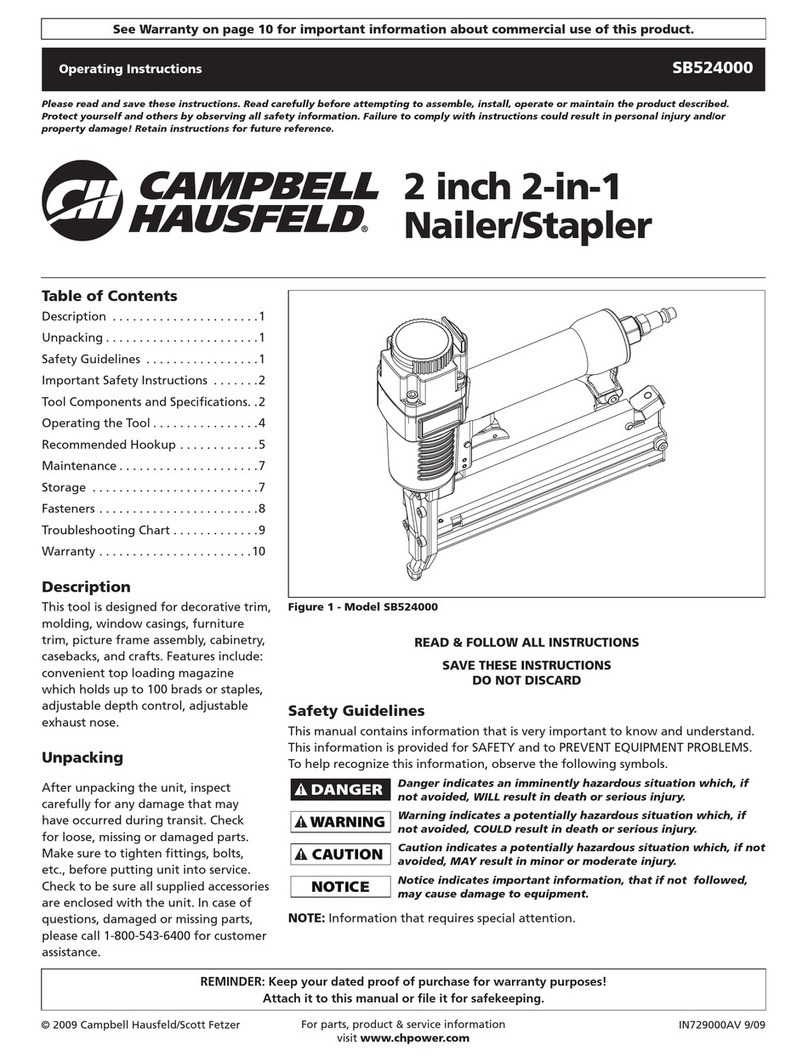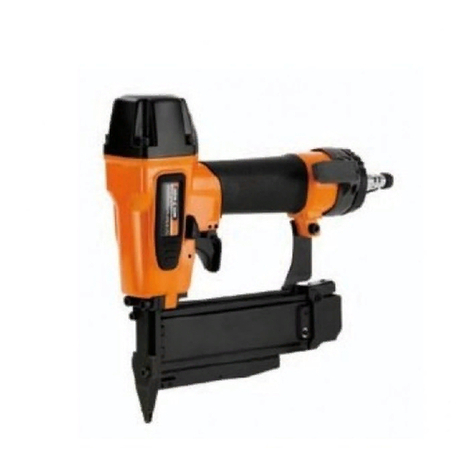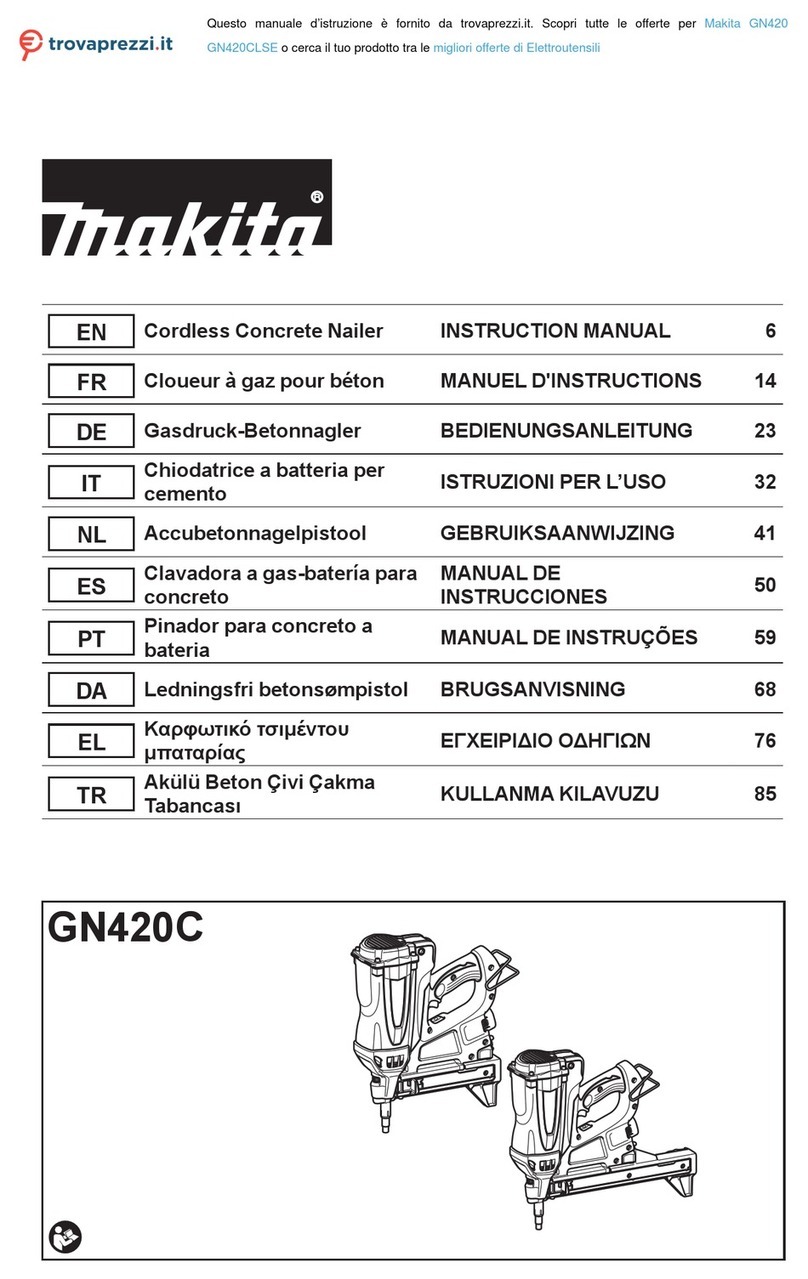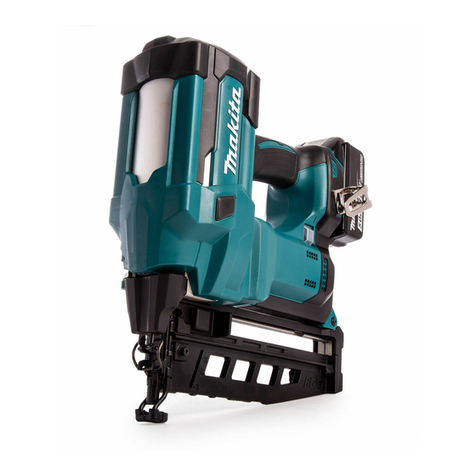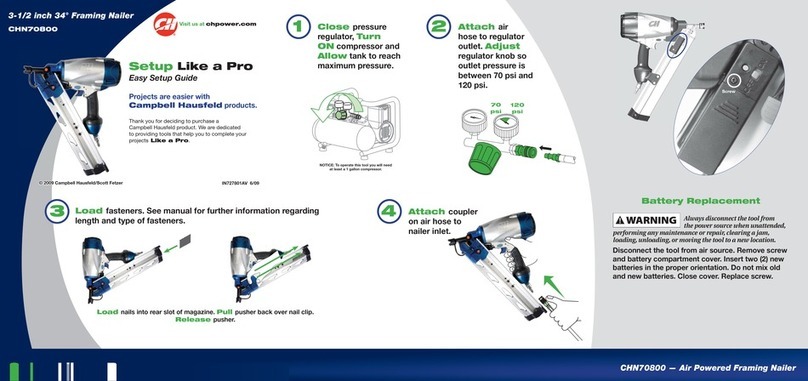Estwing EFL50Q User manual

02
Table of Contents Safety Information
Do not nail on top of another nail. This can cause the
nail to be deflected and hit someone, or cause the
tool to react and result in a risk of injury to persons.
Alwaysweareyeprotection.Operatorandothersin
theworkareashouldalwayswearANSI-approved
safetygoggleswithsideshields.Eyeprotectionis
usedtoguardagainstflyingfastenersanddebris,
whichmaycausesevereeyeinjury.
Alwayswearhearingprotectionwhenusingthetool.
Prolongedexposuretohighintensitynoisemay
causehearingloss.
Use safety equipment. A dust mask, non-skid
safety shoes and a hard hat must be used for the
applicable conditions. Wear a full face shield if you
are producing metal filings or wood chips.
Dressproperly.Donotwearlooseclothingorjewelry.
Containlonghair.Keepyourhair,clothing,andgloves
awayfrommovingparts.Looseclothes,jewelry,or
longhaircanbecaughtinmovingparts.
Stay alert, watch what you are doing and use
common sense when operating a power tool. Do
not use tool while tired or under the influence of
drugs, alcohol, or medication. A moment of
inattention while operating the tool may cause
serious injury.
Keep proper footing and balance at all times.
Proper footing and balance enables better control
of the tool in unexpected situations.
Do not use on a ladder or unstable supports.
Stable footing on a solid surface enables better
control of the tool in unexpected situations.
Make sure the hose is free of obstructions or
snags. Entangled or snarled hoses can cause loss
of balance or footing and may become damaged,
resulting in possible injury.
Do not overreach. Keep proper footing and balance
at all times. Proper footing and balance enables
better control of the tool in unexpected situations.
Do not attach the hose or tool to your body. Attach
the hose to the structure to reduce the risk of loss of
balance if the hose shifts.
WARNING: This product can expose you to
chemicals including lead, which is known to the
State of California to cause cancer and
birth defects or other reproductive harm.
Read operator’s manual: To reduce the risk of
injury, user must read and understand operator's
manual before using this product.
Eye protection: Always wear safety goggles,
safety glasses with side shields, or a full face
shield whenoperating this product.
Hearing protection: Always wear hearing
protector such as earplugs and ear muffs when
using this tool Failure to do so may result in .
hearing loss .
Risk of serious personal injury: Never place
hands or any other body parts in the fastener
discharge area of the nailer, the tool might eject
a fastener and could result in death or serious
personal injury.
Keep the work area clean and well . Cluttered lit
benches and dark areas increase the risks of
accidents.
Do not operate the tool in explosive atmospheres,
such as in the presence of flammable liquids,
gases, or dust. The tool creates a spark which may
ignite flammable liquids, gases or dust.
Keep bystanders, children, and others away while
operating the tool. Distractions could result in
improper use and cause injury.
Avoid unintentional misfires. Always use caution to
avoid accidentally firing. Do not point towards yourself
or anyone whether it contains fasteners or not.
SYMBOLS
WORK AREA SAFETY
1.
2.
3.
4.
WARNING: Instructions pertaining to a risk of fire,
electric shock, or injury to persons.
PERSONAL SAFETY
WARNING: To avoid serious personal injury, do
not attempt to use this product until you read the
manual thoroughly. Save this manual and review
frequently to ensure safe opeartion and instruct
others who may use this tool.
WARNING: When using tools, basic precautions
should always be followed, including the
followings.
1.
2.
3.
4.
5.
6.
7.
8.
9.
10.
11.
03
Table of contents---------------------------------------------2
Safety information--------------------------------------------3
Symbols----------------------------------------------------3
Work area safety-------------------------------------------3
Personal safety---------------------------------------------3
Tool use and care------------------------------------------4
Tool service-------------------------------------------------5
Air source---------------------------------------------------5
Operation---------------------------------------------------5
Air supply and connections-------------------------------5
Loading the tool--------------------------------------------6
Warranty-------------------------------------------------------6
Unpacking-----------------------------------------------------7
Specifications--------------------------------------------------7
Features-------------------------------------------------------8
Operation -----------------------------------------------------8
Loading cleat nails---------------------------------------8
Loading staples--------------------------------------------9
Unloading cleat nails and staples-----------------------9
Changing the foot plate---------------------------------10
Setting the air pressure---------------------------------11
Operating the tool---------------------------------------11
Clearing jams--------------------------------------------12
Maintenance-------------------------------------------------13
Anti-dust cap--------------------------------------------13
Lubrication-----------------------------------------------13
Cleaning--------------------------------------------------14
Cold weather operation--------------------------------14
Recommended hookup------------------------------------14
Troubleshooting---------------------------------------------15

05
04
Always assume that the tool contains fasteners. Do
not point the tool toward yourself or anyone whether
it contains fasteners or not.
Wash hands after handling. This product or its power
cord may contain chemicals known to the State of
California to cause cancer and birth defects or other
reproductive harm.
12.
13.
Useclamps tosecureandsupporttheworkpiece toa
stableplatform. Holding a tool by hand or against the
body is unstable and may lead to loss of control and
injury.
Keep the tool and its handle dry, clean and free from
oil and grease. Always use a clean cloth when
cleaning. Never use brake fluids, gasoline, petroleum-
based products, or any strong solvents to clean your
tool.
Do not use the tool as a hammer.
Never use this tool in a manner that could cause a
fastener to be directed toward anything other than
the workpiece.
Never use gasoline or other flammable liquids to
clean the tool. Never use the tool in the presence of
flammable liquids or gases. Vapors could ignite by a
spark and cause an explosion which will result in
death or serious personal injury.
Always fit the tool with a fitting or hose coupling in a
way that all of the remaining compressed air is
discharged when tool is disconnected. Do not use a
check valve or any other fitting which allows air to
remain in the tool. Death or serious personal injury
could occur.
Never place hands or any other body parts in the
fastener discharge area of the tool. The tool might
eject a fastener and could result in death or serious
personal injury.
Never carry the tool by the air hose or pull the hose to
move the tool or a compressor. Keep hoses away
from heat, oil and sharp edges. Replace any hose that
is weak, worn, or otherwise damaged. Personal injury
or tool damage could ocur.
Always assume the tool contains fasteners. Respect
the tool as a working implement; no horseplay.
Always keep others at a safe distance from the work
area in case of accidental discharge of fasteners. Do
not point the tool toward yourself or anyone whether
it contains fasteners or not. Accidental triggering of
the tool could result in death or serious personal
injury.
Do not drop or throw the tool. This could result in
damage that will make the tool unusable or unsafe. If
the tool has been dropped or thrown, examine the
tool closely for air leaks or bent, cracked or broken
parts. STOP and repair before using to avoid serious
injury.
Avoid using the tool when the magazine is empty.
Accelerated wear on the tool may occur.
Clean and check all air supply hoses and fittings
before connecting the tool to an air supply. Replace
any damaged or worn hoses or fittings to prevent
reduced performace or durability.
10.
11.
12.
13.
14.
Knowthistool.Readthismanualcarefully,learnits
applicationsandlimitations,aswellasthespecific
potentialhazardsrelatedtothistool.
Use only fasteners are recommended for your
models. Do not use the wrong fasteners or load
the fasteners incorrectly.
Use only accessories that are identified by the
manufacturer for the specific tool model. Use of
unauthorized parts or failure to follow maintenance
instructions may create a risk of injury.
Use only those fasteners recommended for use with
this tool. Fasteners not identified for use with this tool
by the tool manufacturer could result in a risk of injury
to persons or tool damage when used in this tool.
Checkformisalignmentorbindingofmovingparts,
breakageofparts,andanyotherconditionthatmay
affectthetool’soperation.Ifthetoolisdamaged,
havethetoolservicedbeforeusing to prevent
accidents.
Maintaintoolswithcare.Keepthemclean.Properly
maintainedtools are easier to control and reduce the
risk of injury.
Store tools out of the reach of children and other
untrained people. Tools are dangerous in the hands
of untrained users.
Check operation of the tool before use.
Use the right tool for the job. The correct tool will do
better and be safer than forcing the wrong tool to do
something other than it was designed for.
1.
2.
3.
4.
5.
6.
15.
16.
17.
Do not use the tool if it leaks air or does not
function properly.
Do not operate the tool if it does not contain a
legible warning label.
Always carry the tool by the handle. Never carry the
tool by the air hose.
18.
19.
20.
21.
23.
25.
22.
24.
Respect the tool as a working implement.
Neverengageinhorseplay.
Keepothersasafedistancefromthetoolwhile
toolisinoperationasaccidentalactuationmay
occur,possiblycausinginjury.
7.
8.
9.
Safety Information (Continued) Safety Information (Continued)
TOOL USE AND CARE TOOL SERVICE
Useonlyaccessories for thespecifictoolmodel as
identified by the manufacturer.
When servicing a tool, use of unauthorized parts of
failure of following maintenance instructions may
create a risk of injury.
Useonlythelubricantsspecifiedbythemanufacturer
or suppliedwiththetool.
Tool service must be performed only by qualified
repair professional.
1.
2.
3.
4.
PERSONAL SAFETY(CONTINUED)
WARNING: Disconnect the tool from the air
source before making adjustments, doing tool
maintenance, clearing jams, touching the safety
yoke, leaving work area, or unloading the tool.
Such precautionary measures reduce the risk of
injury.
TOOL USE AND CARE(CONTINUED)
AIR SOURCE
Never connect to an air source that is capable of
exceeding 200 psi. Over pressurizing the tool is able
to result in bursting, abnormal operation, breakage of
the tool or serious injury to persons. Use only clean,
dry, regulated compressed air at the rated pressure
or within the rated pressure range as marked on the
tool. Always verify prior to using the tool that the air
source has been adjusted to the rated air pressure or
within the rated air-pressure range.
Never use oxygen, carbon dioxide, combustible
gases or any bottled gas as an air source for the tool.
Such gases are capable of explosion and serious
injury to person.
1.
2.
OPERATION
Donotdrivefastenersnear theedgeofmaterial.The
workpiecemaysplitcausingthefastenertoricochet,
injuringyouorpeoplearound.
Duringnormalusethetoolwillrecoilimmediatelyafter
drivingafastener.Thisisanormalfunctionofthetool.
Attempting to prevent the recoil by holding the tool
against the work piece may cause a second fastener
to release. Restriciting the tool can result in serious
personal injury.
1.
2.
3.
4.
5.
Donotdrivefastenersontopofotherfastenersorwith
thetoolatanoverlysteepangleasthismaycause
deflectionoffastenerswhichcouldcauseinjury.
Donotactivatethetoolunlessyouintendtodrivea
fastenerintotheworkpiece.
Always handle the tool with care:
1)
2)
3)
AIR SUPPLY AND CONNECTIONS
Do not use a connector that allows the tool to hold
pressure when the air supply is disconnected. If an
incorrect fitting is used, the tool can remain
pressurized and will be able to drive a fastener even
after the air line is disconnected.
Use filtered, lubricated, regulated compressed air as
your only air source. Do not use any type of reactive
gases including, but not limited to oxygen and
combustible gases. Using reactive gas instead of
compressed air may cause the tool to explode, which
will cause death or serious personal injury.
Use only a pressure-regulated compressed air
source to limit the air pressure supplied to the tool.
Do not exceed 115 psi.
Always disconnect air source:
1.
2.
3.
4.
Before unloading or making adjustments.
When maintaining the tool.
When clearing a jam.
When touching the safety yoke.
When tool is not in use.
When moving to a different work area.
Such precautionary measures reduce the risk of injury to
persons.
1)
2)
3)
4)
5)
6)

Compatible with generic brands of 15.5 gauge staples & 16
gauge L-cleats.
(16 Ga. L Cleats)
7.2mm (9/32”)
38 mm
45 mm
50 mm
1-1/2”
1-3/4”
2”
(15.5 Ga. Staples)
12.7mm (1/2”)
38 mm
45 mm
50 mm
1-1/2”
1-3/4”
2”
07 06
Safety Information (Continued)
LOADING THE TOOL
Do not load the tool with fasteners when any one of
the operating controls is activated.
Never place a hand or any part of body in the fastener
discharge area of the tool.
Never point tool at anyone.
1.
2.
3.
Unpacking
Air inlet: 1/4 inch NPT
Magazine capacity: L Cleat: 100 pcs Staple: 90 pcs
Weight: 8.0 lbs
Maximum pressure: 115 psi
Pressure range: 70 psi – 115 psi
Pin size range: 1-1/2 in. to 2 in.
WARNING: The warnings and precautions
discussed above cannot cover all possible
conditions and situations that may occur. It
must be understood by the user that common
sense and caution are factors which cannot be
built into this product, but must be supplied by
the user.
Specifications
1.
2.
3.
4.
5.
6.
1.
4.
2.
3.
This tool kit has been shipped completely
assembled.
Carefully remove the tool and any accessories from
thebox.
Inspectthetoolcarefullytomakesurenobreakageor
damageoccurredduringshipping.
Do not discard the packing material until you have
carefullyinspectedandsatisfactorilyoperatedthet
ool.
WARNING: If any parts are missing, do not
operate the tool until the missing parts are
replaced. Failure to do so could result in possible
serious personal injury.
WARNING: Do not attempt to modify the tool or
create accessories not recommended for use
with the tool. Any such alteration or
modification is misuse and could result in
hazardous condition leading to possible serious
personal injury.

09
08
Features
Loading cleat nails
1
Connect the tool to the air source.
Pull the pusher (A) back to the end of magazine. Lock
the pusher in the place by using the lock button(B).
(See figure 1 & 2)
Insert strip of L cleats into magazine from the top. Up
to 100 cleat nails can be loaded into the magazine.
Noted that, when loading the L cleats, the side with
the L head should be in the left of the magazine. (See
figure 3)
Press the lock button(B), allow the pusher (A) to slide
forward and engage the fastener. The pusher (A) will
stop when it rests against the end of cleat nails. (See
figure 4)
Operation (Continued)
Unloading cleat nails and staples
3
Figure 1
Operation
1.
2.
3.
4.
Slide Back
Pusher(A)
Lock Button(B)
Figure 3
Figure 2
L Cleat
Figure 7
Lock Button(B)
Staple
Staple
Slide Forward
Ergonomically designed handle
For ease of operation and reduced fatigue.
Non-marring design
Provides increased protection from marring when
working with a finished flooring surface.
Quick jam release
Allows for easy access clearing in the event of a jam.
1.
2.
3.
4. Durable construction
Lightweight, high-strength aluminum body with heat
treated steel parts.
Fiberglass mallet with rubber head included
5.
Figure 5
Figure 6
WARNING: The tool may fire when it is first
connected to the air source. Always connect the
tool to the air source before loading fasteners to
prevent injury from unintended cycling. Always
make sure the tool’s magazine is empty at the
beginning of each work session, before
connecting to air source.
WA R N I N G : U s e only those fasteners
recommended for use with this tool. Fasteners
not identified for use with this tool by the tool
manufacturer can result in a risk of injury to
persons or tool damage when used in this tool.
Disconnect the tool from the air source.
Pull the pusher back to the end of magazine until it is
locked into lock button. ( See figure 8 & 9)
Unload the cleat nails or staples from the magazine.
(See figure 10 & 11)
1.
2.
3.
L Cleat
Figure 4
Loading staples
2
Connect the tool to the air source.
Pull the pusher (A) back to the end of magazine. Lock
the pusher in the place by using the lock button (B).
(See figure 1 & 2)
Insert a full clip of 1/2 in. crown staples into magazine
from the top. You can load up to the 90 pieces into the
magazine. (See figure 5)
Press the lock button(B), allow the pusher (A) to slide
forward and engage the staples. The pusher (A) will
stop when it rests against the end of staples. (See
figure 6 & 7)
1.
2.
3.
4.

11
10
Operation (Continued) Operation (Continued)
Figure 8
Slide Back
Pusher(A)
Figure 9
Lock Button(B)
Figure 10
WARNING: Disconnect the tool from the air
source whenever changing the foot plate.
Make sure there is no fastener in the magazine
before changing the foot plate.
Changing the foot plate
4
Staple
L Cleat
Screws (E)
Foot plate (D)
Setting the air pressure
5The amount of air pressure required depends on the
size of the fasteners and the workpiece material.
Begin testing the depth of drive by driving a test nail
into the same type of workpiece material used for the
actual job.
Drive a test fastener with the air pressure set at 90-95
psi.
Raise or lower the air pressure to find the lowest
setting that will perform the job with consistent
results.
Operating the tool
6
Attach the tool to the air source. Start your
compressor and check the pressure, making sure it is
set between 70-115 psi. Do not exceed the maximum
115 psi.
Hold the hand grip (J) securely and press the foot
plate (D) to the work surface. Make sure the plate is
over the fastener target position.
Press down firmly so that the foot plate (D) is firmly
contacting the work surface. Then, using the mallet
packed with the tool, strike the hammer cap (K) firmly
to drive the fastener into work surface. Lift the tool off
the work surface. Repeat this process until the job is
completed.
1.
2.
3.
4.
1.
2.
3.
The flooring nailer is designed for tongue and groove
flooring only. Place the nailer flush onto the work surface
and ensure that you are striking at the tongue of the
hardwood floor.
Tongue and groove flooring
WARNING: Extreme caution must be used
whenever this tool is connected to an air source.
If the tool is dropped, or if the hammer cap (K) is
accidentally struck, then the tool will fire a
fastener, potentially causing SERIOUS
PERSONAL INJURY.
WARNING: Keep your feet off the tool.
When finished, make sure to store the tool in a clean,
dry, safe location out of reach of children and other
unauthorized People.
4.
Correct Placement
SUBFLOOR
Incorrect Placement
Lcleat
or
Staples
TONGUE & GROOVE
FLOORING TONGUE & GROOVE
FLOORING
SUBFLOOR
NOTE: Please follow your wood manufacture’s guideline
when doing your flooring installations.
WARNING: Before using the tool on a floor, test
the tool on a scrap piece of wood. Adjust the
driving depth by providing more or less air
pressure. Never exceed 115 PSI.
Figure 11 Figure 12
Disconnect the tool from the air source.
Empty the magazine completely.
Fire the tool into a piece of scrap wood to ensure
there is no compressed air or fasteners left in the tool.
Set the tool on its side to expose the four screws (E).
Remove the four screws (E), then remove the foot
plate(D). (See figure 12)
Align the four screw holes in the replacement foot
plate with the four threaded mounting holes.
Using the four screws you removed, secure the
replacement foot plate to the tool.
Ensure the correct foot plate is installed by firing into
a scrap piece of flooring and checking for proper
fastener placement.
The tool is equipped with a factory pre-installed 3/4 in.
foot plate (D), and an additional uninstalled 5/8 in. & 9/16
in. foot plate .
To change the plate:
1.
2.
3.
4.
5.
6.
7.
8.
Lcleat
or
Staples

13
12
Operation (Continued)
WARNING: An improperly functioning tool must
not be used. Do not actuate the tool unless the
tool is placed firmly against the work piece.
Hammer cap (K)
Hand grip (J)
Clearing jams
7
Occasionally, fasteners may become jammed in the firing
mechanism of the tool, making the tool inoperable. To
remove a jammed fastener, follow the steps below:
WARNING: Make sure there is no fastener in the
magazine before clearing a jam.
Figure 14
Figure 15
Figure 16
WARNING: Any time inspection, maintenance,
and cleaning are done:
Disconnect the tool from the air source.
Empty the magazine completely.
Anti-dust cap
Each tool is packed with an anti-dust cap on the air
connector, check it after unpacking.
Keep the anti-dust cap to cover the air connector when
the tool is not in use.
Maintenance
1)
2)
Lubrication
Frequent, but not excessive, lubrication is required for
best performance. Oil for the tool added through the air
line connection add will lubricate the internal parts. Do
not detergent oil or additives as these lubricants will
cause accelerated wear to the seals and bumpers in the
tool, resulting in poor tool performance and frequent tool
maintenance.
Disconnect the air supply from the tool to add
lubricant.
1.
Disconnect the tool from air source.
Empty the magazine. Make sure all fasteners are
removed.
Try to fire the tool into a piece of scrap wood or
flooring to make sure that it's incapable of firing any
fasteners.
Pull up on the latch (F) and open the jam release (G).
(See figure 14 & 15)
Remove the jammed fastener, using plier or a
screwdriver if required.
1.
2.
3.
4.
5.
Close the jam release (G) and latch (F). (See figure 16)
Reload the tool with fasteners, then reconnect the air
source to the tool.
Press the drive guide (H) against a piece of wood, and
test fire the fasteners several times to check for
proper operation. If the tool is properly firing, you may
continue using the tool. If the tool fails to perform
properly, immediately discontinue use and have the
tool repaired by a qualified service technician.
6.
7.
8.
Figure 13
Latch
(F)
Jam Release
(G)
Driver Guide
(H)
Turn the tool so the air inlet is facing up. Place 2-3
drops of pneumatic fastening tool oil into air inlet. Do
not use detergent oils, oil additives, or air -tool oils.
Do not use detergent oil or additives as these
lubricants will cause accelerated wear to the seals
and bumpers in the tool, resulting in poor tool
performance and frequent tool maintenance.
After adding oil, run tool briefly. Wipe off any excess
oil from the cap exhaust.
2.
3.

15
14
Maintenance (Continued)
CAUTION: Lubricate tool only with specified
lubricants.
CAUTION: The work surface can become
damaged by excessive lubrication. Proper
lubrication is the owner’s responsibility. Failure to
lubricate the tool properly will dramatically
shorten the life of the tool and void your warranty.
Avoid using solvents when cleaning plastic parts. Most
plastics are susceptible to damage from various types of
commercial solvents and may be damaged by their use.
Use clean cloths to remove dirt, dust , oil, grease, etc.
CAUTION: Do not at any time let brake fluids,
gasoline, petroleum-based products, penetration
oils, ect. come in contact with plastic parts.
Chemicals can damage, weaken or destroy
plastic which may result in serious personal injury.
For cold weather operation, near and below freezing, the
moisture in the air line may freeze and prevent tool
operation. We recommend the use of air tool lubricant or
permanent antifreeze (ethylene glycol) as a cold weather
lubricant.
CAUTION: Do not store tools in a cold weather
environment to prevent frost or ice formation on
the tools’ operating valves and mechanisms that
could cause tool failure.
CAUTION: The air compressor must be able to
maintain a minimum of 70 psi when the tool is
being used. An inadequate air supply can cause a
loss of power and inconsistent driving.
The air compressor must be able to maintain a
minimum of 70 psi when the tool is being used. An
inadequate air supply can cause a loss of power and
inconsistent driving.
An oiler can be used to provide oil circulation through
the tool. A filter can be used to remove liquid and
solid impurities which can rust or gum up internal
parts of the tool.
Always use air supply hoses with a minimum working
pressure rating equal to or greater than the pressure
from the power source if a regulator fails, or 150
psi,whichever is greater. Use 3/8 in. air hose for runs
up to 50 ft. and use a 3/8 in. quick coupler on the air
hose.
Cleaning
Cold weather operation
Recommended hookup
1.
2.
3.
Use a pressure regulator on the compressor, with an
operating pressure of 0-125 psi. A pressure regulator
is required to control the operating pressure of the
tool between 70 and 115 psi.
4.
WARNING: Stop using tool immediately if any of the following problems occur. Serious personal injury could result. Any
repairs or replacements must be done by a qualified service person or an authorized service center.
Air leaking in head cap.
Loose screw.
Worn or damaged o-rings or seals.
Tighten screws.
Install overhaul kit.
Lack of power.
Slow to cycle.
Tool is too dry.
Air pressure too low.
Exhaust blocked.
Add about 2-3 drops of
lubrication into the air connector.
Make sure the air compressor is
set between 70 psi and 115 psi.
Clean exhaust channel.
Drive channel is worn.
Piston is broken or worn.
Bent fasteners.
Dirty magazine.
Loose magazine.
Wrong fasteners.
Fasteners are jammed
in the tool frequently.
Possible cause(s) Corrective action
Fix the drive channel.
Replace the piston.
Remove the bent fasteners
Clean magazine.
Tighten screws.
Verify that fasteners are the
correct size.
Problems
Damaged pusher spring.
Wrong size of fasteners.
Not shooting fasteners. Replace spring.
Use 16 gauge L cleat nails &
15.5 gauge staples.
Troubleshooting
1.
2.
1.
2.
3.
1.
2.
1.
2.
3.
4.
5.
6.
1.
2.
1.
2.
3.
1.
2.
1.
2.
3.
4.
5.
6.
WARNING: Do not connect with an air
compressor that can potentially exceed 200 psi.
As tool may burst and cause injury.
Quick
connector
Quick
Coupler Air hose Oiler
Regulator
Filter
Compressor
Quick
connector
Quick
Coupler
Learn more about air tools on our website.
Other manuals for EFL50Q
1
Table of contents
Popular Nail Gun manuals by other brands

Makita
Makita FN001G instruction manual
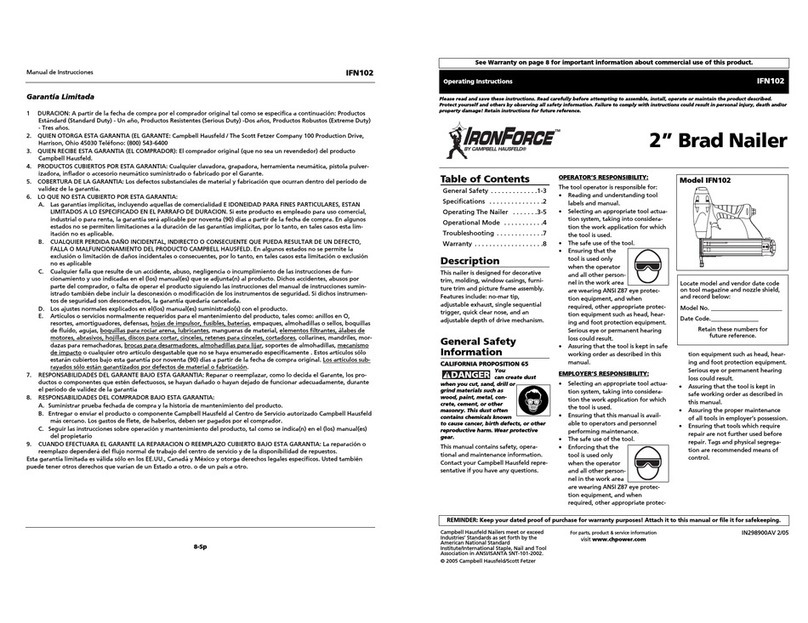
Campbell Hausfeld
Campbell Hausfeld IronForce IFN102 operating instructions

DeWalt
DeWalt D51844 instruction manual
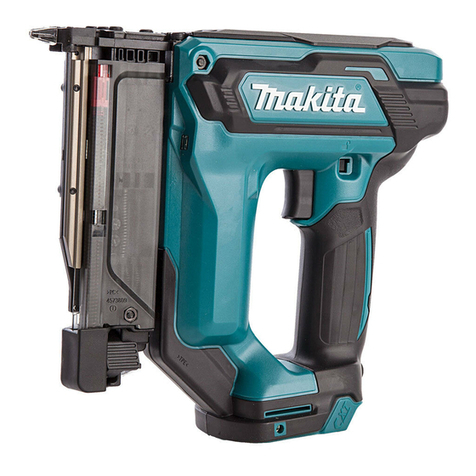
Makita
Makita PT354D instruction manual
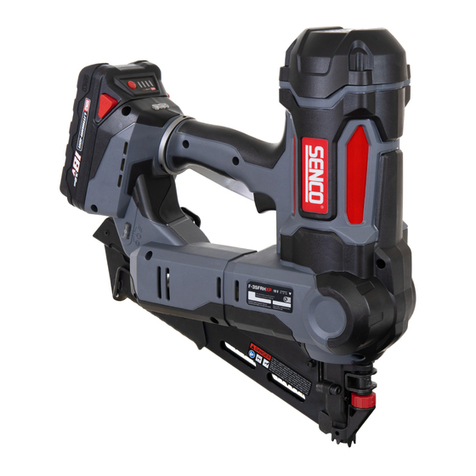
Senco
Senco FUSION F-35FRHXP Parts reference guide

Novus
Novus J-171 Translation of the original operating instructions

